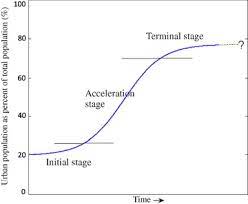Urbanization is a term used to describe the process by which people move from rural areas to urban centers, in search of better opportunities, services, and lifestyles. This phenomenon has been occurring for centuries, but it has accelerated in recent times, particularly in developing countries. In this article, we will explore the concept of the urbanization curve and its relevance to modern-day urbanization.

The urbanization curve is a graphical representation of the relationship between the level of urbanization and economic development. It shows how the percentage of people living in urban areas changes as a country’s economy grows. The curve typically has three stages, each characterized by different rates of urbanization.
First Stage
The first stage is the initial stage of urbanization, where the percentage of the population living in urban areas is low, usually below 20%. This is typical of developing countries, where agriculture is the dominant economic activity, and the majority of the population lives in rural areas.
Second Stage
The second stage is the rapid urbanization stage, where the percentage of the population living in urban areas increases rapidly, usually between 20% and 60%. This stage is associated with economic growth and structural transformation, as people move from agriculture to other sectors such as manufacturing and services.
Third Stage
The third stage is the mature urbanization stage, where the percentage of the population living in urban areas levels off, usually at around 80%. This stage is characterized by a slower rate of urbanization, as most of the population has already moved to urban areas, and the urbanization process is mainly driven by natural increase rather than rural-urban migration.
Implication
The urbanization curve has significant implications for economic development and urban planning. In the initial stage of urbanization, there is a need to invest in rural development to improve agricultural productivity and reduce rural-urban migration. In the rapid urbanization stage, there is a need to invest in urban infrastructure, such as housing, transportation, and basic services, to support the growing urban population.
In the mature urbanization stage, the focus shifts to urban renewal and revitalization, to ensure that existing urban areas remain livable and sustainable. This includes investments in urban green spaces, public transportation, and affordable housing.
In conclusion, the urbanization curve is a useful tool for understanding the relationship between urbanization and economic development. It provides insights into the different stages of urbanization and the challenges and opportunities associated with each stage. By understanding the urbanization curve, policymakers and urban planners can make informed decisions to promote sustainable and inclusive urban development.
Important Links